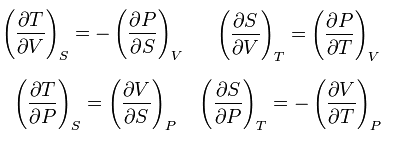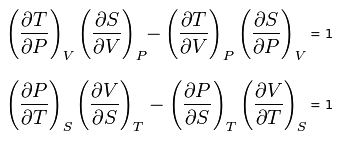Maxwell's Other Equations
April 6, 2011
There's going to be a lot of press this year about
James Clerk Maxwell, since it's been 150 years since the publication of
Maxwell's equations of
electromagnetism.[1-2] These short equations, as now written in the
nomenclature of a more
modern physics, are enough to make a
physicist cry; but there are two types of tears. The older professors are brought to tears because of the beauty of the equations, and the younger students are crying when they discover that they need to make sense out of these
arcana. This is one case in which
Wikipedia, although much beloved by this author, won't be of much help.
Maxwell's principal discovery was the idea that
light is an
electromagnetic wave. Building on
Faraday's earlier demonstrations that an
electric current (a movement of
charges) will generate a
magnetic field; and a changing magnetic field will cause a current that also causes a changing electric field, Maxwell had the idea that electricity and magnetism could feed on each other in a
bootstrap of co-creation. A time-varying electric field would create a time-varying magnetic field, and this resulting object is a light wave.
The importance of an idea can be seen in the number of times that it's reused.
John Archibald Wheeler invented a bootstrapped object he called the
geon. A geon is an electromagnetic (or
gravitational) wave which holds itself together in a small region of space because of the gravitational attraction of its own
field energy. Wheeler thought this could be a model for
elementary particles, although it's still not known whether such objects would be stable. The same problem existed for the
electron before
quantum mechanics. According to classical theory, electrons are not stable, since they would
radiate energy in their orbit around the nucleus, finally spiraling into it.

John Wheeler autographed one of his books[3] for me in March, 2000. As you can see, Wheeler, who lived in the years 19xx for 88 years of his life, was still not accustomed to Y2K.
Maxwell was also fond of
statistical mechanics, as the
Maxwell–Boltzmann distribution demonstrates, and there are some other Maxwell equations that are not the ones that are being celebrated. These equations, which are now denigrated to being merely
Maxwell's relations, involve all the important
thermodynamic quantities; and, like one form of his electromagnetic equations, these are
differential equations, as shown below.

Maxwell's Thermodynamic Equations.
(Modified, from Wikipedia)
These equations involve the three quantities with which Boyle would be familiar,
pressure (P),
volume (V) and
temperature (T); and they include
entropy (S). The equations are obtained through manipulation of the equations involving the
thermodynamic potentials; namely,
dG = -SdT + VdP
dH = TdS + VdP
dU = TdS - PdV
dA = -SdT - PdV
Theses equations relate the
Gibbs free energy (G),
enthalpy (H),
Helmholtz free energy (A) and the
system internal energy (U) to measurable quantities. A little
mathematical manipulation gives you the following interesting relations.

Maxwell's Thermodynamic Equations.
(Modified, from Wikipedia)
These equations are fun to look at because of their
symmetry, and they form the basis of a lot of subsequent thermodynamics. Aside from a few homework problems while I was in school, I've never used them directly; but their fingerprints are all over two of my most popular reference books.[4-5]
References:
- Editorial - A bold unifying leap, Nature, vol. 471, no. 7338 (March 17, 2011), p. 265.
- Simon Schaffer, "The laird of physics,"Nature, vol. 471, no. 7338 (March 17, 2011), pp. 289-291.
- John Archibald Wheeler with Kenneth William Ford, "Geons, Black Holes, and Quantum Foam: A Life in Physics," W. W. Norton & Company; (First Edition, August 1998), 380 pages (via Amazon).
- C. E. Wicks and F. E. Block, "Thermodynamic Properties of 65 Elements - Their Oxides, Halides, Carbides, and Nitrides," U. S. Bureau of Mines Bulletin 605, U. S. Government Printing Office (1963).
- L. B. Pankratz, "Thermodynamic Properties of Elements and Oxides," U. S. Bureau of Mines Bulletin 672, U. S. Government Printing Office (1982).
Permanent Link to this article
Linked Keywords: James Clerk Maxwell; Maxwell's equations; electromagnetism; nomenclature; modern physics; physicist; arcanum; arcana; Wikipedia; light; electromagnetic wave; Faraday; electric current; electric charge; magnetic field; bootstrap of co-creation; John Archibald Wheeler; geon; gravitational wave; field energy; elementary particles; electron; quantum mechanics; Bremsstrahlung; statistical mechanics; Maxwell–Boltzmann distribution; Maxwell's relations; thermodynamics; differential equations; pressure; volume; temperature; entropy; thermodynamic potential; Gibbs free energy; enthalpy; Helmholtz free energy; system internal energy; mathematics.